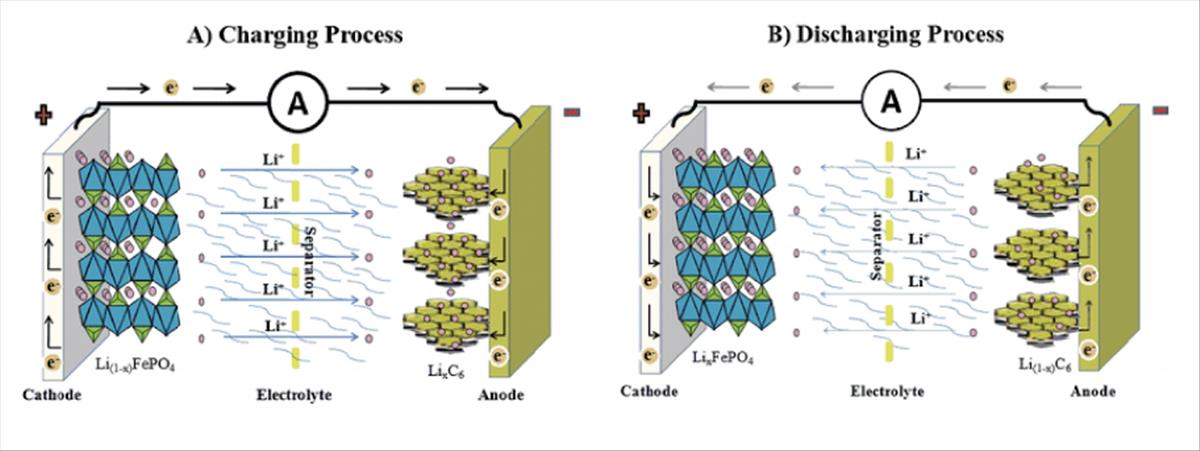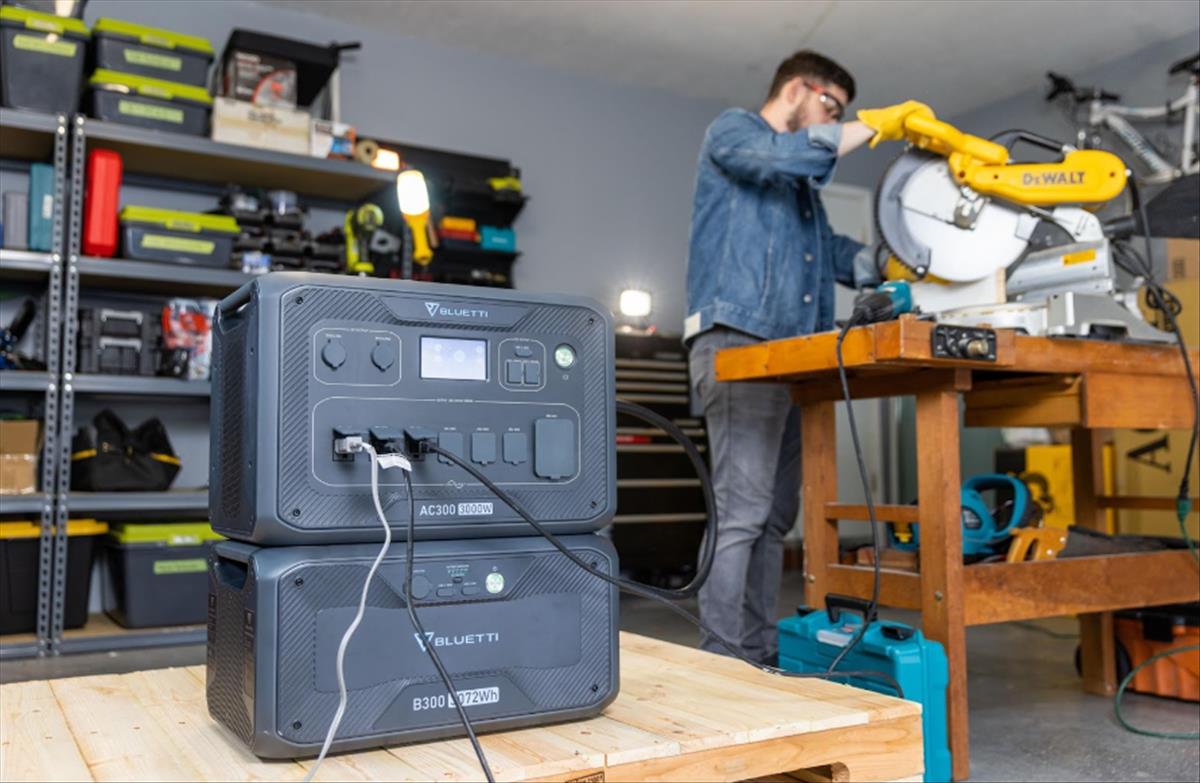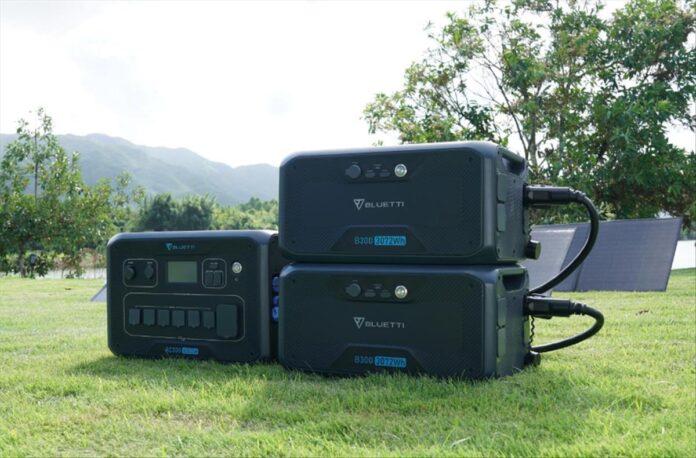It all started with the EB150 and EB240 solar generators, the first Bluetti products launched in 2019.
About a year later, they launched their flagship model, the AC200, on Indiegogo (powered by NCA cells), as a crowdfunding campaign.
This project raised almost 7 million dollars in two months.
Since then, Bluetti has been at the forefront of technological innovation, equipping all of its new products with LFP technology over NCM, NCA and lithium-ion battery chemistry.
You may be wondering why they did this. Well, in this article, we aim to explain their reasoning as best we can.
What are LiFePO4 Batteries?
LFP or LiFePO4 stands for lithium iron phosphate and was invented in 1996.
For all you science fans, the anode material is LiaC6 and the cathode material is LibFePO4, the carrier being Li+.
LFP batteries provide some of the best electrochemical performance with the lowest additional resistance on the market.
This is made possible by the nanometer-scale phosphate cathode material found in the battery.
This allows the following benefits:
- long life cycle
- Thermal stability
- Highest Current Ranking
- An extra layer of security
How do LiFePO4 batteries work?

An LFP battery is essentially made up of the following components:
- Positive electrode (cathode)
- Negative electrode (anode)
- Electrolyte
- Separator
- Lithium metal oxide (LiFePO4)
- Graphite
- lithium salt
- Polymer membrane loading
Burden
When a LiFePO4 battery is charged, lithium ions are released from the cathode and move towards the anode. They do it through the electrolyte.
Download
When an energy load is applied to the battery, the opposite reaction takes place. Lithium ions move from the anode to the cathode.
This movement of lithium ions creates a flow of electrons between these two electrodes, which generates an electrical charge.
LiFePO4 batteries vs. NCM & Lithium Ion Batteries
For this section, we thought it best to create a comparison table of Bluetti, Jackery, and Ecoflow.
Bluetti uses LiFePO4, Jackery lithium-ion and Ecoflow NCM.

(For the reader’s information, we couldn’t find a comparable capacity size for Jackery, so we’re including their largest capacity generator, which is 1534 Wh.)
Next, what we want to do is calculate the LCOS or Levelized Cost of Storage in USD/Wh.
When it comes to energy storage, one cannot simply rely on the actual purchase price of the solar generator (initial cost).
We must also take into account the total energy in watt-hours that the solar generator can store and release (the charge/discharge cycle) during its lifetime.
The formula to calculate the LCOS is as follows:
LCOS = Initial Cost / (Total Capacity kWh x (DoD %) x Life Cycle)
Let’s calculate the LCOS for each solar generator manufacturer and their respective product models.
Bluetti
2 kWh x 0.9 x 3500 = 6300
$1,799 / 6,300 = $0.285 per kWh
jackery
1.5 kWh x 0.8 x 500 = 600
$1,599 / 600 = $2.67 per kWh
eco flow
2 kWh x 0.8 x 800 = 1280
$1,899 / 1,280 = $1.48 per kWh
As we can see by calculating the LCOS, Bluetti is by far the much cheaper option in the long run, and this is because LiFePO4 technology lasts much longer than Lithium Ion and NCM.
Please note that the LCOS above includes other components such as the charge controller and inverter as these two components are included in the initial purchase price.
Why LiFePO4 batteries are perfect for solar generators

To highlight this section, we thought it best to highlight all the advantages that LFP batteries have and why they are the most suitable for solar generators.
Light
LiFePO4 batteries are known to be lightweight compared to other battery technologies. This is particularly important when your application is inside a solar generator. The lighter a generator is, the more mobile it is. For example, the new Bluetti AC200 MAX weighs only 28.1kg.
While this may seem like a lot at first glance, you need to remember how much energy storage capacity this machine has. For all that energy density, 61 pounds is next to nothing.
Long useful life
Perhaps one of the greatest advantages of the LFP battery is its ability to be charged and discharged thousands of times.
In the case of Bluetti, its latest solar generators can discharge more than 3,500 times.
This is an important decision-making factor for consumers looking to invest in high-quality products that will last them for many years. LiFePO4 technology allows it.
High efficiency
Unlike lead-acid batteries, LFP batteries are incredibly efficient. You can use up to 90% of its capacity, which means you can get the most out of your solar generator in as little space as possible.
Generally, LiFePO4 batteries can be discharged beyond 90% of their capacity.
No active maintenance
LFP batteries are virtually maintenance free. This means you don’t need to do anything to extend its life. You can simply upload and download as you see fit.
Safety
LiFePO4 batteries are indeed safer than NCM batteries. In fact, they are the safest lithium-ion batteries on the market.
These batteries are encased in an airtight aluminum case specifically designed to withstand variations in temperature, pressure, punctures and shock.
Extreme temperatures
Bluetti’s solar generators can operate in a wide range of temperatures, which means they can be used for a variety of applications.
Temperature is not something to be overlooked when it comes to battery performance, and it can have a profound effect on any battery. However, LiFePO4 has the best chance in extreme temperature variants.
Last conclusions
If you are looking for the safest solar generator with the greatest possibility of providing you with long-term energy storage, then all Bluetti solar generators equipped with the latest LFP technology are your best choice.
Models like the new AC200 MAX and AC300 , with a modular power system, are capable of giving you incredible amounts of power storage.
For example, the AC300 has the ability to reach a maximum of 240V, 6000W and a total of 24,576Wh when combined with our Fusion Box Pro. This allows you to connect two AC300 units in series and connect up to 8 × B300 (four for each AC300).













